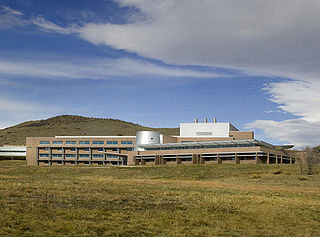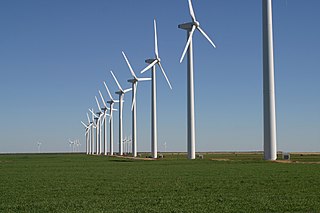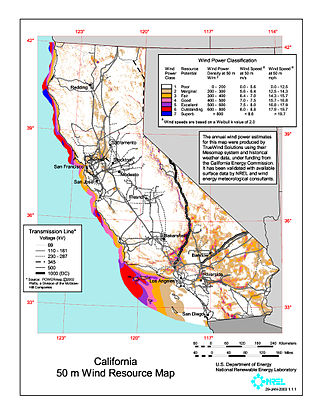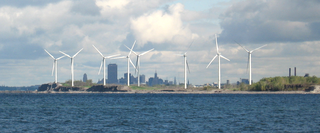United Technologies Corporation (UTC) was an American multinational conglomerate headquartered in Farmington, Connecticut. It researched, developed, and manufactured products in numerous areas, including aircraft engines, aerospace systems, HVAC, elevators and escalators, fire and security, building automation, and industrial products, among others. UTC was also a large military contractor, getting about 10% of its revenue from the U.S. government. Gregory J. Hayes was the CEO and chairman.

The National Renewable Energy Laboratory (NREL) in the US specializes in the research and development of renewable energy, energy efficiency, energy systems integration, and sustainable transportation. NREL is a federally funded research and development center sponsored by the Department of Energy and operated by the Alliance for Sustainable Energy, a joint venture between MRIGlobal and Battelle. Located in Golden, Colorado, NREL is home to the National Center for Photovoltaics, the National Bioenergy Center, and the National Wind Technology Center.
Merchant wind power (MWP) is a framework of developing electricity from wind turbines placed on land owned by brown-field sites, such as those of heavy industry. The wind-turbine operators then supply the land owners with power at reduced rates.

The Tehachapi Pass wind farm is one of the first large-scale wind farms installed in the U.S., with around 710 megawatts (950,000 hp) produced by about 3400 wind turbines.

Wind power is a branch of the energy industry that has expanded quickly in the United States over the last several years. From January through December 2022, 434.8 terawatt-hours were generated by wind power, or 10.25% of electricity in the United States. The average wind turbine generates enough electricity in 46 minutes to power the average American home for one month. In 2019, wind power surpassed hydroelectric power as the largest renewable energy source in the U.S.

Wind power in California had initiative and early development during Governor Jerry Brown's first two terms in the late 1970s and early 1980s. The state's wind power capacity has grown by nearly 350% since 2001, when it was less than 1,700 MW. In 2016, wind energy supplied about 6.9% of California's total electricity needs, or enough to power more than 1.3 million households. Most of California's wind generation is found in the Tehachapi area of Kern County, California, with some large projects in Solano, Contra Costa and Riverside counties as well. California is among the states with the largest amount of installed wind power capacity. In recent years, California has lagged behind other states when it comes to the installation of wind power. It was ranked 4th overall for wind power electrical generation at the end of 2016 behind Texas, Iowa, and Oklahoma. As of 2019, California had 5,973 megawatts (MW) of wind power generating capacity installed.

According to data from the US Energy Information Administration, renewable energy accounted for 8.4% of total primary energy production and 21% of total utility-scale electricity generation in the United States in 2022.
The American Wind Energy Association (AWEA) was a Washington, D.C.–based national trade association formed in 1974, representing wind power project developers, equipment suppliers, service providers, parts manufacturers, utilities, researchers, and others involved in the wind industry.

Clipper Windpower is a wind turbine manufacturing company founded in 2001 by James G.P. Dehlsen. It designed one of the largest wind turbines in the United States, manufactured in Cedar Rapids, Iowa. It was working collaboratively with the National Renewable Energy Laboratory.

The 2.5 MW Liberty Wind Turbine was the largest wind turbine manufactured in the United States when it was first installed in 2007. It was developed through a partnership with U.S. Department of Energy and its National Renewable Energy Laboratory for Clipper Windpower.

Steel Winds is a wind energy project located on the coast of Lake Erie in Lackawanna, New York, just south of the City of Buffalo in Erie County. Its first phase was operational in 2007 and the second phase came online in 2012, for a combined production capacity of 35 MW. The unique project was built on part of the brownfield of a former Bethlehem Steel plant. By using much of the existing infrastructure of roads and transmission lines, it could reduce project costs. It is one of the largest urban wind farms in the world and uses turbines manufactured in Iowa.

Making up over 62% of the state's generated electricity in 2022, wind power is the largest source of electricity generation in Iowa. In 2020, over 34 billion kWh of electrical energy was generated by wind power. As of 2022, Iowa has over 12,200 megawatts (MW) of installed capacity with over 6,000 wind turbines, ranking second and third in the nation below Texas respectively.

A floating wind turbine is an offshore wind turbine mounted on a floating structure that allows the turbine to generate electricity in water depths where fixed-foundation turbines are not feasible. Floating wind farms have the potential to significantly increase the sea area available for offshore wind farms, especially in countries with limited shallow waters, such as Spain, Portugal, Japan, France and the United States' West Coast. Locating wind farms further offshore can also reduce visual pollution, provide better accommodation for fishing and shipping lanes, and reach stronger and more consistent winds.
The Titan Wind Project is 25MW wind farm which had a proposed expansion to 5,050 MW, formerly known as Rolling Thunder, based in South Dakota. The project developers, Clipper Windpower and BP Alternative Energy, expected to build Titan in several phases and, when completed, it would have been one of the largest wind farms in the world.

Offshore wind power or offshore wind energy is the generation of electricity through wind farms in bodies of water, usually at sea. There are higher wind speeds offshore than on land, so offshore farms generate more electricity per amount of capacity installed. Offshore wind farms are also less controversial than those on land, as they have less impact on people and the landscape.
GE Wind Energy is a branch of GE Renewable Energy, a subsidiary of General Electric. The company manufactures and sells wind turbines to the international market. In 2018, GE was the fourth largest wind turbine manufacturer in the world.

Wind power in Michigan is a developing industry. The industrial base from the automotive industry has led to a number of companies producing wind turbine parts in the state. The development of wind farms in the state, however, has lagged behind. In January 2021, there were a total of 1,481 wind turbines in the state with a nameplate capacity of 2,549 MW. The nameplate total exceeded 2,000 MW when Pine River came online in March 2019. Wind provided 4.2% of the state's electricity in 2016.
Envision Energy is a Chinese multinational corporation headquartered in Shanghai that provides wind turbines and energy management software. Envision has long-term strategic cooperations in the area of battery manufacturing with Renault, Nissan, Daimler and Honda.
The Chokecherry and Sierra Madre Wind Energy Project is large-scale wind farm located near Rawlins, Wyoming, currently under construction. If completed as scheduled in 2026, it is expected to become the largest wind farm in the United States and one of the largest in the world. Located largely on federal lands, the project is being built in conjunction with the TransWest Express transmission line to supply power to the California market. Originally slated for completion in 2020, the goal was extended to 2026 in 2019 amid permitting, environmental, and construction delays.











